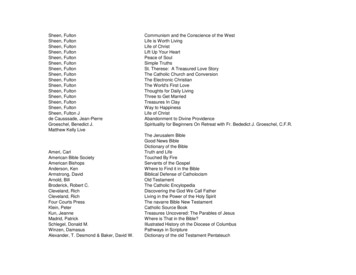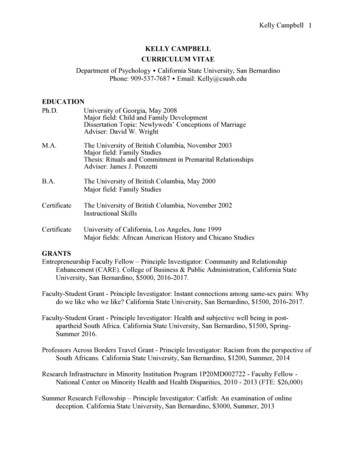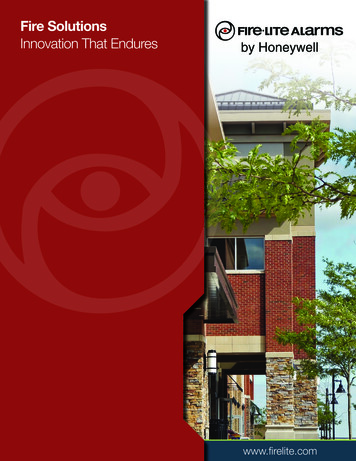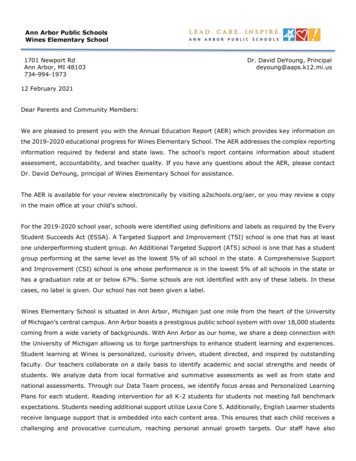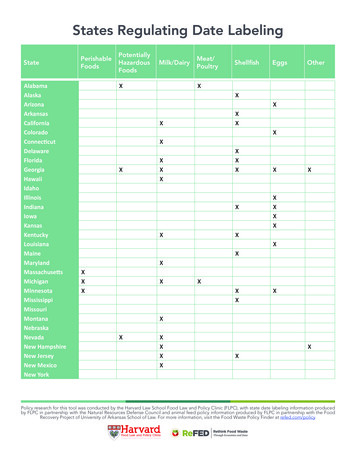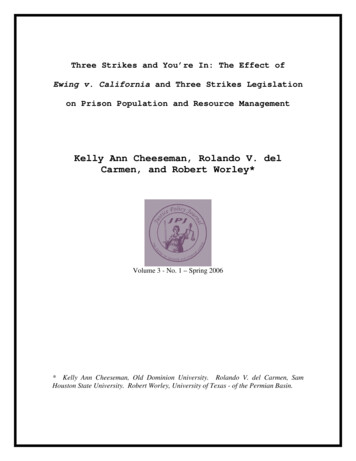
Transcription
Three Strikes and You’re In: The Effect ofEwing v. California and Three Strikes Legislationon Prison Population and Resource ManagementKelly Ann Cheeseman, Rolando V. delCarmen, and Robert Worley*Volume 3 - No. 1 – Spring 2006* Kelly Ann Cheeseman, Old Dominion University. Rolando V. del Carmen, SamHouston State University. Robert Worley, University of Texas - of the Permian Basin.
Abstract“Three strikes” laws have been a source of great debate since their inception.The recent Supreme Court decision in Ewing v. California (2003), upholding California’sthree strikes laws will undoubtedly have an effect on prison management as prisonpopulations continue to rise and correctional budgets continue to decrease. This paperexamines the legal history of “three strikes” legislation and explores the impact theselaws have on the criminal justice system, particularly prison populations andcorrectional budgets as well as the recent surge in the number of geriatric prisoners.2
About the AuthorsKelly Cheeseman is an instructor of Criminal Justice at Old Dominion University. Kellyhas published articles, in refereed journals such as Deviant Behavior, CorrectionsManagement Quarterly and Criminal Law Bulletin. Her current research interestsinclude institutional corrections, deviance, the death penalty, sexual offending, socialpolicy, and women and crime. She has been employed with two major correctionalsystems: Texas and the Federal Bureau of Prisons.Rolando V. del Carmen is Distinguished Professor of Criminal Justice (Law) at SamHouston State University. He has published several books and numerous articles in law.His areas of expertise are: criminal procedure, corrections law, juvenile law, legalliabilities of public officials, rights of public officials, and probation and parole law.Robert Worley is an ABD at Sam Houston State University. He has published articlesrelated to correctional officer-inmate inappropriate relationships, in journals such asDeviant Behavior and Crime and Justice International. Mr. Worley’s current researchinterests include sex offender registration, family violence, and white collar-crime.3
Three Strikes and You’re In: The Effect of Ewing v. California and Three StrikesLegislation on Prison Population and Resource re-out laws” are one of America’s more controversialsentencing practices. Although the phrase is commonly used, states vary widely on whatis meant by “three,” “strikes,” and “out.” (Reichel, 2001). By 1996 twenty five states hadsome variation of three strikes, while thirty-four states maintain some form of habitualoffender laws (Dimasco and Mauer, 1995). Despite the many variations in “three strikes”legislation, some basic similarities exist. Three strikes laws authorize longer periods ofincarceration for violent crimes, which could include murder, rape, arson and aggravatedassault (Clark, Austin, and Henry, 1997). Some states include drug sales, escape, treason,embezzlement and bribery (Clark et al., 1997).Many states have “habitual offender”legislation, which allow persons to be incarcerated for life after a specified number ofsentences. Legislations that targets repeat offenders are not new, but confinement for lifefor these types of offenders has spawned debate. The Supreme Court in Ewing v.California (2003) decided that three strikes laws are constitutional and do not violate theEighth Amendment. This decision has a profound impact on the correctional system.This paper examines the cases decided prior to the Ewing v. California (2003)decision and traces the legal history and rulings on habitual offender and three strikeslaws. It then explores current legislation and examines the variations in state and federallegislation. Another focus is the effect three strikes laws have had on prison populations.Long determinate sentences created by the legislation will have an adverse impact on theprison population, financial costs, and management. The increase in the number of4
geriatric inmates is an additional concern resulting from three strikes legislation. Thefinal part of this paper will discuss the future of three strikes and implications of theEwing decision.Supreme Court CasesSince 1980 the United States Supreme Court has decided seven cases \on the issueof the constitutionality of long and disproportionate prison sentences, particularly thoseinvolving life imprisonment for relatively minor offenses. These cases are based on theEighth Amendment prohibition against cruel and unusual punishment. They generallyuphold the statutes constitutionality with a few notable exceptions.Rummel v. Estelle (1980)In 1980 the Court decided Rummel v. Estelle (1980) Rummel had received a felonyconviction for obtaining 120.75 by false pretenses and received a mandatory lifesentence.Believing the sentence to be disproportionate to the types of offensescommitted, Rummel argued that it was a violation of the Eighth Amendment for Texas tosentence a three time offender a life sentence despite the possibility of parole. Under theTexas recidivism statute Rummel was sentenced to a lengthy prison term for a convictionof felony theft. His two prior offenses were a conviction for fraudulent use of a creditcard and passing a forged check, both felony convictions. Because Texas had previouslyincarcerated Rummel for felony convictions the Court held that it was not unreasonableto incarcerate this individual for life, as he had proven he was unable to conduct himselfunder the prescribed social norms (Rummel v. Estelle, 1980). The Rummel Court alsoheld that the proportionality of sentences can rarely be contested except in capitalpunishment cases.The Court held that only an extreme example, such as making5
overtime parking punishable by life imprisonment would constitute a violation of theproportionality principle in non capital punishment sentences.Hutto v. Davis (1982)After Rummel v. Estelle (1980), the Court heard Hutto v. Davis (1982). In thatcase, law enforcement officers raided respondent’s home and seized approximately nineounces of marijuana and assorted drug paraphernalia. Several days before the raid,officers had tape-recorded a transaction in which respondent sold marijuana and othercontrolled substances to a police informant. With the aid of the seized evidence and thetape recording, the defendant in the case was sentenced to two consecutive twenty yearterms for possession to distribute nine ounces of marijuana. At the time of respondent’sconviction, Virginia law authorized fines of up to 25,000 and prison terms of not lessthan 5 nor more than 40 years for each of respondent’s offenses. The Court relied onRummel saying that federal courts should be cautious in overturning mandatory prisonsentences approved by the legislature.The Court again implied that successfulchallenges to the proportionality of prison sentences should be rare occurrences (Hutto v.Davis, 1982).Solem v. Helm (1983)The Court decided Solem v. Helm (1983) three years after Rummel. In 1979, therespondent was convicted in a South Dakota state court of uttering a “ no account” checkfor 100. Ordinarily the maximum punishment for that crime would have been five years’imprisonment and a 5,000 fine. Helm was sentenced to life imprisonment withoutpossibility of parole under South Dakota's recidivist statute because of his six prior felonyconvictions, three convictions for third-degree burglary and convictions for obtaining6
money under false pretenses, grand larceny, and third-offense driving while intoxicated.The Court had held that the constitutional principle of proportionality has beenrecognized by the Court for over a century (Solem v. Helm 1983). Solem’ s sentence oflife without the possibility of parole for a seventh offense was unconstitutional becausethe triggering offense was a “ no account” check for 100. The Court held that threefactors were relevant to the determination of whether or not a sentence is constitutionallydisproportionate: (1) the gravity of the offense and the harshness of the penalty, (2) thesentences imposed on other criminals of the same jurisdiction, and (3) the sentencesimposed for commission of the same crime in other jurisdictions. The main differencebetween Solem and Rummel was the possibility of parole. The defendant in Rummelcould receive parole when eligible; however, the petitioner in Solem would serve asentence of life without the possibility of parole, making his sentence a violation of theEighth Amendment.Harmelin v. Michigan (1991)Harmelin v. Michigan (1991) differed from the previous cases in that the issuewas not recidivism but sentence proportionality. Harmelin was a first time offender whowas convicted of possessing almost 700 grams of cocaine.He was subsequentlysentenced to life without the possibility of parole. Although the majority of the Courtagreed that the sentence was not drastically disproportionate, there was disagreement asto why the petitioner’ s proportionality argument failed (Singletary, 1993). Justice Scaliaand Chief Justice Rehnquist believed that the proportionality aspect involved capitalsentences and death penalty offenses, and was not generalizable to the EighthAmendment (Harmelin v. Michigan, 1991). Justice Kennedy disagreed saying that the7
proportionality principle does apply to non capital sentences. Justice Kennedy discussedfour principles of proportionality review: (1) the primacy of the legislature, (2) the varietyof legitimate penological schemes, (3) the nature of the federal system and (4) therequirement that proportionality review be governed by objective factors (Singletary,1993). Citing Solem v. Helm (1983), he stressed that, “ The Eighth Amendment does notrequire strict proportionality between crime and sentence, rather it forbids only extremesentences that are ‘grossly disproportionate’ to the crime” (Solem v. Helm, 1983).People v. Romero (1994)In 1994 the District Attorney of San Diego County charged defendant JesusRomero with possession of a controlled substance (.13 grams of cocaine) (People v.Romero, 1994).Defendant had also been charged with two prior serious felonies,burglary and attempted burglary, which made him eligible for a life sentence underCalifornia’ s “ Three Strikes” law. If the prior convictions did not exist the defendant’ ssentence would have been from three to six years. Romero pleaded not guilty. The trialcourt indicated it was willing to consider striking the prior felony conviction allegationsif Romero changed his plea to guilty. The prosecutor objected and argued that the courthad no power to strike the prior convictions in a “ Three Strikes” case unless asked to doso by the prosecutor. The defendant then changed his plea to guilty and the court struckthe prior convictions. Under California statute §1385, the judge or magistrate may, eitherof his or her own motion or upon the application of the prosecuting attorney, and in thefurtherance of justice, order an action to be dismissed. This section does not authorize ajudge to strike any prior conviction of a serious felony for purposes of enhancement of asentence under §667. The district attorney argued that §1385 referred to the Three8
Strikes law. The Supreme Court of California concluded that the court could act on itsown accord to strike prior felony conviction allegations in cases brought under the ThreeStrikes law. Interestingly the court decided to make this retroactive (People v. Belmontes1983). The Superior Court was also clear that the lower court is limited by the conceptwhich requires the dismissal to be in the furtherance of justice.Lockyer v. Andrade (2003)In 2002, a California state prisoner was convicted of two counts of petty theft andsentenced under California’ s Career Criminal Punishment Act, which is California’ sthree strikes law (Lockyer v. Andrade, 2003). In November of 1995 Andrade stole fivevideotapes from a Kmart and again stole four video tapes 14 days later at a differentKmart store (Lockyer v. Andrade, 2003). He had been in and out of state and federalprison since 1982 for burglary, twice convicted of transportation of marijuana, petty theftand escape from a federal prison. Andrade admitted that he stole the tapes to buy heroin.Under California law any felony can constitute a third strike and subject the defendant to25 years to life in prison. Although the petty theft is not a felony under California law itis a “ wobbler” when coupled with a prior conviction.A “ wobbler” can either beconsidered a misdemeanor or felony by the prosecutor, although the trial court can reducethe charge to a misdemeanor at the time of sentencing. Andrade was subsequentlysentenced to two consecutive terms of 25 years to life. After exhausting his appeals, theAndrade filed a habeas corpus petition arguing that two consecutive terms of 25 years tolife for stealing video tapes worth only 150 was grossly disproportionate to the crimeand a violation of the 8th Amendment. The Court conceded that it had not clearly defined9
whether or not a particular sentence for a term of years could violate the 8th Amendment(Harmelin v. Michigan, 1991).The Court relied on the Rummel v. Estelle (1980) Solem v. Helm (1983) andHarmelin v. Michigan (1991) for its definition of “ grossly disproportionate.” It held inSolem that the gross disproportionality principle is one rarely used and only in extremecases. The facts of the case fell between the facts of Rummel and Solem. Andrade,unlike Solem, had the possibility of parole. The Court felt that the facts were notindistinguishable from either Rummel or Solem. Some Justices expressed uncertainty overthe application of the proportionality principle to California’ s three strikes laws, but thesereservations were unpersuasive to the majority in Lockyer (Riggs v. California, 1999).The majority believed that the decision by California to uphold the two consecutive termsof 25 years to life was not an unreasonable application of precedent. It also noted thatage was not an important factor in the sentencing decision, as argued by the dissent(Robinson v. California, 1962).Two different sentences would not become legallyindistinguishable based solely on the age of the offender.Ewing v. California (2003)The above cases set the stage for the decision in Ewing v. California (2003).Ewing was convicted of felony grand theft for stealing three golf clubs, worth 399apiece. As required by the three strikes law, the prosecutor formally alleged, and the trialcourt found, that Ewing had been convicted previously of four serious or violent felonies.In sentencing him to 25 years to life, the court refused to exercise its discretion to reducethe conviction to a misdemeanor--under a state law that permits certain offenses, knownas "wobblers," to be classified as either misdemeanors or felonies--or to dismiss the10
allegations of some or all of his prior relevant convictions.Three strikes laws, asexplained by one of the architects of California’ s three strikes law, “ were intended to gobeyond simply making sentences tougher. They were intended to be a focused effort tocreate a sentencing policy that would use the judicial system to reduce serious and violentcrime” (Aradiz, 2000). The Court felt that although three strikes laws are relatively new,the history of deferring to state legislatures in making and implementing policy decisionsis longstanding (Gore v. United States, 1958). As noted by Justice Kennedy in Harmelinv. Michigan (1991) the Constitution does not mandate that any one penological theory beadopted.Sentences can and do have a variety of justifications such as deterrence,incapacitation, retribution, and rehabilitation (Clear and Cole, 2003). The Court believedit that state legislatures, not federal courts should determine a state’ s sentencing scheme.The California Legislature did not violate the Eighth Amendment when it enacted thethree strikes law because it was not grossly disproportionate.The Court said thatCalifornia could and should make its own judgment on protecting the public safety of itscitizens. The Court also believed that recidivism was a concern to California and otherstates in the nation.A recent report found that almost two-thirds of former inmates released fromstate prisons were charged with at least one “ serious” new crime within three years oftheir release and the number of recidivists was increasing (Hughes and Wilson, 2002).The majority in Ewing also said that recidivism statutes were designed to deter repeatoffenders, as noted in Rummel. The passage of three strikes laws in California hadlowered the recidivism rate by twenty-five percent (California Department of Justice,1998). Even though the Court acknowledged the controversial nature of three strikes11
legislation it said that its role was not one of “ super-legislature” , but that of an interpreter.The State of California has a reasonable basis for believing that the enhanced sentenceswill advance the goals of its criminal justice system. The defendant in Ewing had stolenthree golf clubs, equating to felony grand theft in California. This was not just a minorconviction, especially when accompanied by his previous convictions for violent andserious felonies. Grand theft is one of California’ s “ wobblers” in which in can either beconsidered a misdemeanor or a felony. It can only be considered a misdemeanor if a trialcourt finds that the offender’ s rehabilitation does not require or would be adverselyaffected by incarceration (In re Anderson, 1968). The Court said the trial judge was notin error by considering the grand theft a felony in light of Ewing’ s previous felonyhistory. Ewing’ s sentence of twenty-five years to life in prison is not unreasonable and isjustified by the state’ s interest in incapacitating and deterring recidivist felons. Ewinghad previously served nine terms of prison confinement. The Court believed the sentencein Ewing was not inappropriate and did not violate the Eighth Amendment’ s prohibitionon cruel and unusual punishments.The cases above present the current United States Supreme Court’ s position onthree strikes laws. Table 1 provides an overview of the decisions in these cases. The caseshave some commonalities and differences. The majority of the cases upheld three strikeslegislation, citing that long sentences for second or third felonies are not grosslydisproportionate, particularly if offenders are eligible for parole. In Solem the Court heldthat a life sentence without the possibility of parole was disproportionate whenconsidering the third strike offense. The Court did not feel that the sentence of lifewithout the possibility of parole was disproportionate for the possession of 700 grams of12
cocaine.The Eighth Amendment provides that a sentence cannot be grosslydisproportionate but, according to the majority in Harmelin v. Michigan (1991), it doesnot require “ strict proportionality.” In both Lockyer v. Andrade (2003) and Ewing v.California (2003), the Court established the validity of California’ s three strikes laws,holding that states should establish their own sentencing schemes.Table 1. Overview of Three Strikes Law Supreme Court Decisions.Case andCitationRummel v.Estelle445 US 263(1980).Hutto v.Davis 454US 370(1982)Solem v.Helm 463US 277(1983)Harmelin v.Michigan501 US 597(1991)IssueHoldingReasonIs it a violation of the 8thAmendment to sentence athree time felony offenderto life with the possibilityof parole? NOWere two consecutivesentences of 20 years fordrug offensesdisproportionate sentences?NOWas a life sentence withoutthe possibility of parole adisproportionate sentencefor a no account check of 100? YESWas a life sentence withoutthe possibility of parole forpossession of 700 grams ofcocaine disproportionate?NOThe sentence imposed bythe state of Texas was notdisproportionate.The proportionality ofsentences can rarely bechallenged for non capitalpunishment cases.The two twenty yearsentences were notdisproportionate to thecrimes committedThe proportionality ofsentences can rarely bechallenged for non capitalpunishment cases.The sentence of life withoutthe possibility of parole isunconstitutional.Because Solem was noteligible for parole thesentence was notproportionate when balancedagainst the crime committed.The Eighth Amendment doesnot require strictproportionality betweencrime and sentence, butforbids sentences that aregrossly disproportionateCalifornia statute §1385states that a judge ormagistrate may order anaction dismissed in thefurtherance of justiceThe Court felt that the factsin Andrade were notindistinguishable from thosein Rummel or Solem.People v.Romero(1994)Can a court strike downprior felony convictionsunder California’ s threestrikes law? YESLockyer v.Andrade 538U.S. 63(2003)Was two consecutive termsof 25 years to life for afelony count of theft ofstolen video tapes adisproportionate sentence?NOWas California’ s threestrikes lawunconstitutional? NOThe sentence of life withoutthe possibility of parole wasnot grossly disproportionateto the crime committedThe court can act of its ownaccord and not considerformer strikes in imposingsentences on offenders whoqualify for “ three strikes”It is not disproportionate tosentence an individual totwo consecutive terms of 25years to life for a “ wobbler”offense.Ewing v.The state statute does notStates should determine theirCaliforniaviolate the Eighthown sentencing schemes and538 US 11Amendment of thenot the federal judiciary.(2003)Constitution.Source: Clark, J., J. Austin and D. A. Henry (1997). “ Three Strikes and You’ re Out: A Review of StateLegislation,” National Institute of Justice.13
A Supreme Court decision has jurisdictional effect on the entire United States, sothe ruling in Ewing has given all states in the United States the freedom to create threestrikes legislation without fear of reversal. Of particular concern is what effect this willhave on current legislatures. Will the upholding of three strikes legislation in Ewing havea profound impact on correctional systems and penological treatment?Current LegislationTwenty-four states currently have three strikes laws. Many of these states vary ontheir definitions of “ three strikes,” as some require only two strikes such as Montana orArkansas while Maryland and Florida have “ four strikes” (Vitello, 1997).Table IIpresents an overview of three strikes legislation in the United States.Table 2. Variations in State Strike Laws (Clark and Henry, 1997)StateStrike ZoneStrikesneededto be outMeaning of OutArkansasMurder, kidnapping, robbery,rape, terrorist actTwoNot less than 40 years, noparoleFist degree batteryFiring gun from vehicleUse of prohibited weaponConspiracy to commit murder,kidnapping, robbery, rape, firstdegree battery, or first degreesexual abuseMurder, rape, lewd act on achild, robbery, attemptedmurder, assault with a deadlyweapon on peace officer, assaultwith intent to rape or rob, arsoncausing bodily injury,carjacking, kidnapping,mayhem, arson, burglary ofoccupied dwelling, drug sales tominors, any felony with deadlyweapon, any felony with afirearm usedThreeRange of no parolesentencesTwoMandatory sentence oftwice the term for theoffense involvedCaliforniaAny felony if two prior felonyconvictions from list ofstrikeable offensesNumber ofpeople inprison underthree strikes542,322Three14Mandatory indeterminatelife sentence, with noparole for 25 years
sianaMarylandAny Class 1 or 2 felony or anyClass 3 felony that is violentThreeMurder, attempted murderAssault with intent to killTwoManslaughter, arson,Kidnapping, aggravated sexualassault, robbery, first degreeassaultThreeAny forcible felony, aggravatedstalking, aggravated child abuse,lewd or indecent conduct,escapeThreeMurder, armed robbery,kidnapping, rape, aggravatedchild molestation, aggravatedsodomy, aggravated sexualbatteryMurder, rape, sexual batterywith weapon, child molestation,arson, robbery, burglary withweapon or resulting in seriousinjury, drug dealingTwoAny felony against a personMurder, attempted murder,manslaughter, rape, armedrobbery, kidnapping, any drugoffense punishable by more than5 years, any felony punishableby more than 12 yearsAny four felony convictions if atleast one was on the above listMurder, rape, robbery, first orsecond degree sexual offense,arson, burglary, kidnapping,carjacking, manslaughter, use offirearm in felony, assault withintent to murder, rape, rob, orcommit sexual offenseMandatory life in prisonwith no parole eligibilityfor 40 yearsUp to 40 years in prison1Up to life in prisonLife if third strikeinvolves first degreefelony, 30-40 years ifsecond degree felony, 1015 years if third-degreefelonyMandatory life withoutparoleThreeMandatory life withoutpossibility of paroleTwoCourt may double termspecified in sentenceguidelinesMandatory life in prisonwith no parole eligibilityThree41,6287,63138N/A330 (Approx.)FourFour,withseparateprisontermsservedfor firstthreestrikes15Mandatory life in prisonwith no parole eligibilityMandatory life in prisonwith no parole eligibility0
MontanaDeliberate homicide, aggravatedkidnapping, sexual intercoursewithout consent, ritual abuse ofa minorMurder, robbery, kidnapping,battery, abuse of a child, arson,home invasionTwoMandatory life in prisonwith no parole eligibilityThreeCourt has option tosentence one of thefollowing: life withoutpossibility of parole; lifewith parole possibilityafter 10 years, or 25 yearswith parole possible after10 yearsNew JerseyMurder, robbery, carjackingThreeNew MexicoMurder, shooting at or fromvehicle and causing harm,kidnapping, criminal sexualpenetration, armed robberyresulting in harmThreeMandatory life in prisonwith no parole eligibilityMandatory life in prisonwith no parole eligibilityNorthCarolina47 violent felonies, separateindictment is required withfinding that offender is “ violenthabitual offender”Any Class A, B, or C felonyTwoNevadaNorthDakotaPennsylvaniaMurder, voluntarymanslaughter, rape, involuntarydeviate sexual intercourse,arson, kidnapping, robbery,aggravated sexual assaultSame offensesSouthCarolinaTennesseeMurder, voluntarymanslaughter, homicide by childabuse, rape, kidnapping, armedrobbery, drug trafficking,embezzlement, bribery, certainaccessory and attempt offensesMurder, especially aggravatedkidnapping, especiallyaggravated robbery, aggravatedrape, rape of a child, aggravatedarsonSame as above, plus rape,aggravated sexual battery,aggravated robbery, especiallyTwoTwoMandatory life in prisonwith no parole eligibilityIf second strike is forClass A, court mayimpose up to life; if ClassB felony, up to 20 years;if Class C felony, up to 10yearsEnhanced sentence of upto ten years304100221050 (Approx.)14ThreeTwoEnhanced sentence of upto 25 yearsMandatory life in prisonwith no parole eligibility14Two, ifprisontermservedfor firststrikeThree, if16Mandatory life in prisonwith no parole eligibilityMandatory life in prisonwith no parole eligibilityN/A
aggravated burglary, especiallyaggravated child abuse,aggravates sexual exploitation ofa childseparateprisontermsservedfor firsttwostrikesUtahAny first or second degreeThreeCourt may sentence from16felony5 years up to lifeVermontMurder, manslaughter, arsonThreeCourt may sentence up tocausing death, assault andlife in prisonrobbery with a weapon orcausing bodily injury,aggravated assault, kidnapping,maiming, aggravated sexual328assault, aggravated domesticassault, lewd conduct with achildVirginiaMurder, kidnapping, robbery,ThreeMandatory life in prisoncarjacking, sexual assault,with no parole eligibility209conspiracy to commit any of theaboveWashingtonMurder, Controlled substanceThreeMandatory life in prisonhomicide, homicide by abuse,with no parole eligibilitymanslaughter, rape, childmolestation, incest of child,robbery, attempted murder,extortion, vehicular assault,9arson, burglary, any felony withdeadly weapon, possession ofprohibited explosive device,treason, promoting prostitution,leading organized crimeMandatory life in prisonWisconsinMurder, manslaughter, vehicular Threewith no parole eligibilityhomicide, aggravated battery,abuse of a child, robbery, sexualassault, taking hostages,kidnapping, arson, burglarySource: Clark, J., J. Austin and D. A. Henry (1997). “ Three Strikes and You’ re Out: A Review of StateLegislation,” National Institute of Justice.Each state defines what it believes is an appropriate offense to count as a strike. Moststates include such offenses as rape, robbery, arson, aggravated assault, and carjacking.Some states add other charges. In Louisiana any drug offense that is punishable by morethan five years is a “ strike.” Maryland and Tennessee also require that the prior offenseshad a sentence of incarceration (Vitello, 1997). Confusion exists as wide variation occurs17
from state to state on what constitutes the strike zone. Additionally, each state varies onthe amount of strikes needed for an “ out.” There is great variation from state to state andto classify all of these statutes as “ three strikes legislation” would be misleading. Crimesthat are considered strikes in one state are not classified as a strikeable offense in anotherstate. The Court, regardless of state definitions of strikes, has ruled that this type oflegislation is constitutional.Does Three Strikes Legislation Achieve Its Intended PurposeFinancial ImpactProponents of three strikes argue that although enforcing three strikes isfinancially expensive, it cannot be compared with the saved costs associated with crimevictimization. It is difficult to attach a monetary value to costs associated with crimevictimization, (such as quality of life, pain, suffering, and fear), neither is it clear thatthree strikes laws are significantly decreasing victimization costs.Correctional andcriminal justice budgets continue to soar (Associated Press, 2003) with bed space inmany state correctional agencies ex
Kelly Cheeseman is an instructor of Criminal Justice at Old Dominion University. Kelly has published articles, in refereed journals such as Deviant Behavior, Corrections Management Quarterly and Criminal Law Bulletin. Her current research interests include institutional corrections, deviance, the death penalty, sexual offending, social .
